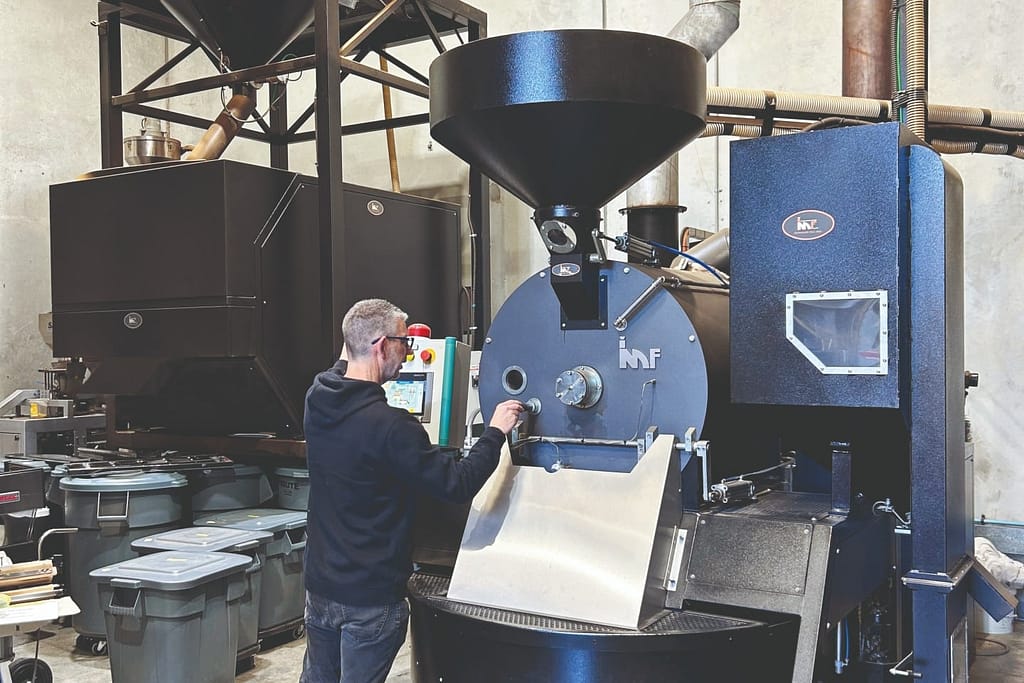Double Roasters Co-founder Scott Robertson on how Roastquip and IMF has helped grow the business and put in on the path to success.
Coffee roasting company Double Roasters opened operations in 2010 with Co-founders Scott Robertson, Gary Parkes, and James Brown. The trio had worked together in past cafés but decided to pivot to the other side of the coffee industry to control the end result.
“At the time, James and Gary had a café and I just sold my own café. We had the same complaints about our coffee roaster suppliers, which inspired us to jump in and do it ourselves,” says Scott.
In 2012, the group purchased a 210 square metre warehouse in Marrickville, New South Wales, and soon realised they’d need to expand.“We were roasting seven days a week just to keep up with demand on a 15-kilogram roaster, which was exhausting,” says Scott.
As such, the Double Roasters team started to think big, and explore what kind of features they wanted from a new roaster.
“By far, the biggest thing we were looking for was automation, so we could take some of the physical part of the job out,” Scott says. “The idea was to get away from the heavy lifting and to have more energy to spend on the coffee side of things.”
Scott says they felt the time was right to stop looking at small capacity roasters and focus on larger, more industrial equipment that could still produce an artisan product for their growing business.
Double Roasters turned to Roastquip, a consultation company and IMF Australasian agent and distributor, which connected them to the Italian manufacturer’s 60-kilogram roaster.
Roastquip Director Will Notaras then designed a roasting plant to accommodate the fit-out in under 80 square metres of space to include six IMF integrated one-tonne silos and a 200-kilogram blender. It provides Double Roasters with the capacity to grow, and enough automation to free-up time for the co-founders to conduct more research and development, and introduce more products.
When green beans arrive at the factory, Double Roasters transport the coffee into the silo hopper using a forklift, before loading it into the appropriate silo. This ensures no manual lifting.
The IMF roaster uses load cells on the silos to weigh the coffee as it’s loaded into the roaster hopper. After roasting and destoning, the IMF software is programmed to load each origin according to the set recipe, and automatically sends it to the blender hopper to discharge once complete.
“When we integrated the silo system, we knew we could then separate two sides of production: loading the silo, and roasting and blending the coffee,” Scott says. “We couldn’t believe the volume we could produce in such a small time frame.”
Between roasts, it takes about 90 seconds for the temperature to reset until the next load is dropped into the drum. This enables up to four batches of 60 kilograms per hour of roasting and saves gas due to reduced waiting times between roasts.
“Ten years ago, not a lot of people were thinking about how much gas we were using, particularly when we were running systems with a separate afterburner,” says Scott. “One of the things we liked [about the IMF roaster] was not using as much gas.”
The IMF roaster uses one burner. It simultaneously heats the beans and incinerates the emissions, then recirculates the heat, saving up to 47 per cent in gas consumption.
Scott says the adaptability of the roaster has stood out, as the control of operations still very much remains with the user and not the machine.“While we wanted to automate production, we still wanted to be fully involved in the process,” he says.
“Although it’s a 60-kilogram roaster, we can roast 15 kilograms [of coffee] in it. Even though there’s a silo system, you can bypass it and load the coffee directly to the roaster.”
While the roaster has seldom caused any problems for Scott and Double Roasters, he takes reassurance in knowing that he can receive help whenever it’s needed.
“Will is always available if we require support and we keep in contact,” says Scott.
“Our roaster connects to the internet and any issues can be diagnosed quickly.”
Scott adds that customers who have toured the Double Roasters facility have been noticeably impressed with the IMF machine.
“Our roaster is 10 years old now, but it still looks and performs like brand new,” he says.
Scott says the IMF roaster has been paramount in building successful relationships with his café partners, which he believes should continue well into the future.
“The fact that I can keep long relationships with customers is because we’re able to keep consistent with the product,” he says. “If you were to ask café owners what they really want, it would be the same coffee every week.
“We can achieve consistency, and it’s helped us grow to what we are now.”
For more information, visit www.roastquip.com.au
This article appears in the October 2023 edition of BeanScene. Subscribe HERE.
This article appears in the October 2023 edition of BeanScene. Subscribe HERE.


